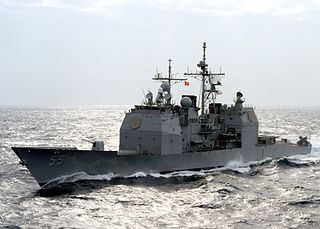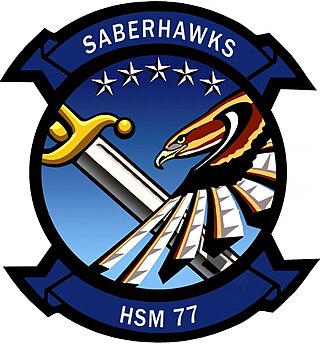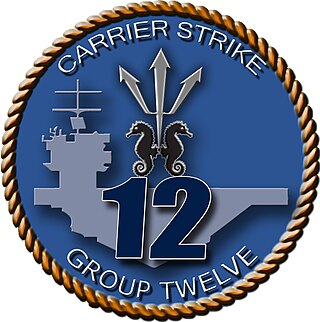
The Nimitz class is a class of ten nuclear-powered aircraft carriers in service with the United States Navy. The lead ship of the class is named after World War II United States Pacific Fleet commander Fleet Admiral Chester W. Nimitz, who was the last living U.S. Navy officer to hold the rank. With an overall length of 1,092 ft (333 m) and a full-load displacement of over 100,000 long tons (100,000 t), the Nimitz-class ships were the largest warships built and in service until USS Gerald R. Ford entered the fleet in 2017.

USS Abraham Lincoln (CVN-72) is the fifth Nimitz-class aircraft carrier in the United States Navy. She is the third Navy ship to have been named after the former President Abraham Lincoln. Her home port is NAS North Island, San Diego, California; she is a member of the United States Pacific Fleet. She is administratively responsible to Commander, Naval Air Forces Pacific, and operationally serves as the flagship of Carrier Strike Group 3 and host to Carrier Air Wing Nine. She was returned to the fleet on 12 May 2017, marking the successful completion of her Refueling and complex overhaul (RCOH) carried out at Newport News Shipyard. On 1 April 2019, USS Abraham Lincoln was deployed to the Middle East as the flagship for Carrier Strike Group 12 and Carrier Air Wing Seven assigned to her.

Carrier Strike Group 9 is a U.S. Navy carrier strike group. Commander Carrier Strike Group 9 is responsible for unit-level training, integrated training, and material readiness for the ships and aviation squadrons assigned to the group. The group reports to Commander, U.S. Third Fleet, which also supervises its pre-deployment training and certification that includes Composite Unit Training Exercises.

USS Bunker Hill (CG-52) was a Ticonderoga-class guided missile cruiser of the United States Navy constructed by Litton-Ingalls Shipbuilding Corporation at Pascagoula, Mississippi and launched on 11 March 1985. The Ticonderoga-class cruisers are equipped with the Aegis Combat System and Bunker Hill is the first of the class to be equipped with the Mark 41 Vertical Launching System (VLS) in place of the previous ships' twin-arm Mark 26 missile launchers, which greatly improved the flexibility and firepower of the ships by allowing them to fire BGM-109 Tomahawk cruise missiles for land attack missions. Other missions include ballistic missile defence and capital ship escort for anti-aircraft defense. The ship was commissioned on 20 September 1986 and was homeported at Naval Base San Diego in San Diego, California.

Fleet Week is a United States Navy, United States Marine Corps, and United States Coast Guard tradition in which active military ships recently deployed in overseas operations dock in a variety of major cities for one week. Once the ships dock, the crews can enter the city and visit its tourist attractions. At certain hours, the public can take a guided tour of the ships. Often, Fleet Week is accompanied by military demonstrations and air shows such as those provided by the Blue Angels.

The USS Thomas S. Gates (CG-51) was a flight-I Ticonderoga-class cruiser that was used by the United States Navy. The warship was named after Thomas S. Gates, Secretary of Defense in the last years of the Eisenhower Administration (1959–1961).

USS Leyte Gulf (CG-55) is a Ticonderoga-class guided missile cruiser in the United States Navy. She was named in memory of the World War II Battle of Leyte Gulf in the Pacific. She is powered by four large gas-turbine engines, and she has a large complement of guided missiles for air defense, attack of surface targets at sea and ashore, and anti-submarine warfare (ASW). In addition, she carries two "Seahawk" LAMPS multi-purpose helicopters, whose primary mission is ASW.

USS San Jacinto (CG-56) was a Ticonderoga-class cruiser in the United States Navy. She is named for the Battle of San Jacinto, the decisive battle of the Texas Revolution.

USS Philippine Sea (CG-58) is a Flight II Ticonderoga-class guided missile cruiser on active service in the United States Navy. She is named for the Battle of the Philippine Sea during World War II and is the second ship to bear the name. She has completed multiple deployments as part of Operation Enduring Freedom from 2001 to 2014.

USS Normandy (CG-60) is a Ticonderoga-class guided-missile cruiser in the service of the United States Navy. Armed with naval guns and anti-air, anti-surface, and anti-submarine missiles, plus other weapons, she is equipped for surface-to-air, surface-to-surface, and anti-submarine warfare. The cruiser was the first US warship since 1945 to go to war on her maiden cruise, and in 1998 was awarded the title "Most Tomahawks shot by a U.S. Navy Cruiser". She is named for the World War II Battle of Normandy, which took place in France on, and following, D-Day.

USS Gettysburg (CG-64) is a Ticonderoga-class guided-missile cruiser in the United States Navy. She is named for the Battle of Gettysburg during the American Civil War.

USS Gonzalez (DDG-66) is an Arleigh Burke-class destroyer in the United States Navy. She is named for Sergeant Alfredo Cantu Gonzalez, a Medal of Honor recipient in the Vietnam War.
The names of commissioned ships of the United States Navy all start with USS, for United States Ship. Non-commissioned, primarily civilian-crewed vessels of the U.S. Navy under the Military Sealift Command have names that begin with USNS, standing for United States Naval Ship. A letter-based hull classification symbol is used to designate a vessel's type. The names of ships are selected by the Secretary of the Navy. The names are those of states, cities, towns, important persons, important locations, famous battles, fish, and ideals. Usually, different types of ships have names originated from different types of sources.

Strike Fighter Squadron 213 (VFA-213), also known as the "Black Lions", is a United States Navy strike fighter squadron based at Naval Air Station Oceana, Virginia.It was established in 1955 and is currently equipped with the F/A-18F Super Hornet. The squadron is assigned to Carrier Air Wing Eight and uses the radio callsign Lion.

USS Gravely (DDG-107) is an Arleigh Burke-class guided missile destroyer in the United States Navy. She is named after Vice Admiral Samuel L. Gravely Jr. Commissioned in 2010, she has been on several overseas deployments.

Helicopter Maritime Strike Squadron Seven Seven (HSM-77) "Saberhawks" is a United States Navy helicopter squadron based at Naval Air Facility, Atsugi, Japan. HSM-77 is attached to Carrier Air Wing Five and deploys aboard USS Ronald Reagan and air capable ships attached to Carrier Strike Group Five (CSG-5). The squadron was established as Helicopter Antisubmarine Squadron (Light) Forty Seven (HSL-47) on 25 September 1987 and was redesignated HSM-77 on 2 Apr 2009.

Carrier Strike Group 10, is a U.S. Navy carrier strike group. As of August 2022, CSG-10 consists of USS George H.W. Bush (CVN-77), the strike group's current flagship, with Carrier Air Wing Seven embarked on board, as well as the Ticonderoga-class cruiserLeyte Gulf, and four ships of Destroyer Squadron 26.

Carrier Strike Group 14 was a U.S. Navy carrier strike group. The group was for some time the only U.S. carrier strike group that did not have an assigned aircraft carrier or carrier air wing. As of December 2010, it directed the cruisers USS Gettysburg (CG-64) and USS Philippine Sea (CG-58). Carrier Strike Group 14 was seemingly last based at Naval Station Mayport. Without a carrier flagship, it did not conduct the typical deployments of other carrier strike groups; instead, its two cruisers made independent voyages.

Carrier Strike Group Nine is a U.S. Navy formation. The group is one of six U.S. Navy carrier strike groups assigned to the U.S. Pacific Fleet. In 2004–09, it was based at Naval Base San Diego and its flagship was the Nimitz-class aircraft carrierUSS Abraham Lincoln (CVN-72).

Carrier Strike Group Twelve is one of four U.S. Navy carrier strike groups currently assigned to the United States Fleet Forces Command. USS Gerald R. Ford is the aircraft carrier assigned as the strike group's flagship. Units currently assigned to Carrier Strike Group Twelve included Carrier Air Wing Eight; the Ticonderoga-class cruisersVicksburg and Normandy; and Destroyer Squadron 2.

















